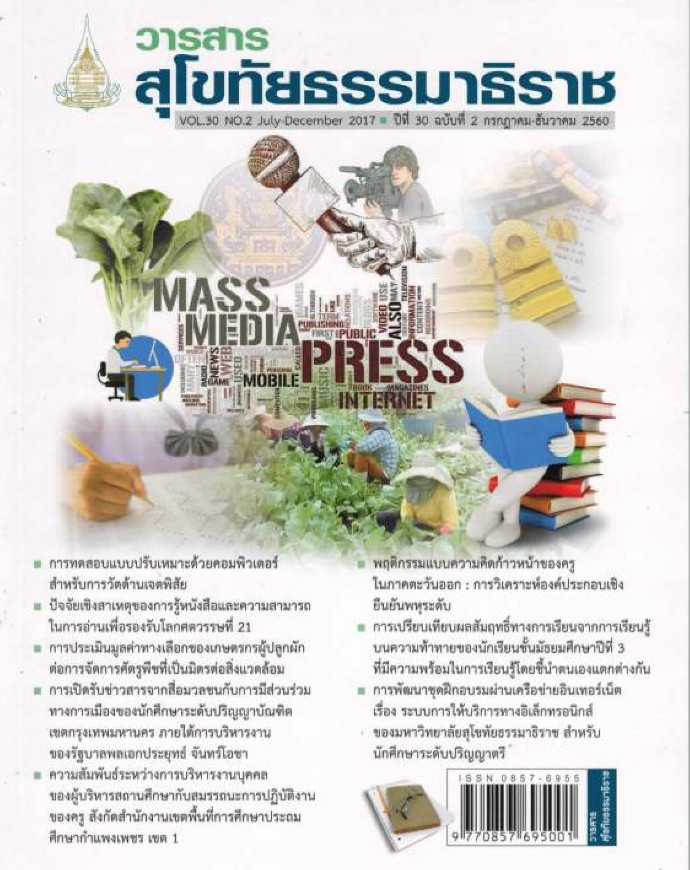การประเมินมูลค่าทางเลือกของเกษตรกร ผู้ปลูกผักต่อการจัดการศัตรูพืช ที่เป็นมิตรต่อสิ่งแวดล้อม
คำสำคัญ:
การจัดการศัตรูพืชแบบผสมผสาน, ความเต็มใจจ่าย, วิธีแบบจำลองทางเลือกบทคัดย่อ
งานวิจัยนี้มีวัตถุประสงค์เพื่อประเมินมูลค่าทางเลือกในการจัดการศัตรูพืชที่เป็นมิตรต่อสิ่งแวดล้อม เนื่องจากที่ผ่านมามาตรการของภาครัฐเพื่อการลดปริมาณการใช้สารเคมีกำจัดศัตรูพืชในประเทศไทยยังไม่ ประสบผลสำเร็จเท่าที่ควร สาเหตุที่สำคัญประการหนึ่งคือ มาตรการเหล่านั้นมักไม่สอดคล้องกับความชอบ ของเกษตรกร งานวิจัยนี้เก็บรวบรวมข้อมูลจากกลุ่มเกษตรกรผู้ปลูกผักจำนวน 303 ครัวเรือน ใน 3 จังหวัด ได้แก่ ราชบุรี นครปฐม และปทุมธานี วิเคราะห์โดยใช้วิธีแบบจำลองทางเลือก ผลการศึกษาพบว่า เกษตรกร ผู้ปลูกผักให้ความสำคัญกับมาตรการจัดการศัตรูพืชที่จะส่งผลดีกับสุขภาพและสิ่งแวดล้อมในระยะยาว ใน ขณะเดียวกันเกษตรกรให้ความสำคัญกับประโยชน์ด้านการฝึกอบรมให้ความรู้ด้านการจัดการศัตรูพืชแบบ ผสมผสาน การมีตรารับรองการจัดการศัตรูพืชที่เป็นมิตรต่อสิ่งแวดล้อมเช่นกัน ดังนั้น เพื่อให้เกษตรกรยอมรับ มาตรการการจัดการศัตรูพืชของรัฐมากขึ้น ภาครัฐจึงควรจัดสรรงบประมาณสนับสนุนการจัดการศัตรูพืชที่เป็น มิตรต่อสิ่งแวดล้อมเพื่อผลประโยชน์ด้านสุขภาพและสิ่งแวดล้อมในระยะยาว รวมทั้งควรจัดฝึกอบรมให้ ความรู้ด้านการจัดการศัตรูพืชแบบผสมผสาน และพิจารณาศึกษาความเป็นไปได้ในการรับรองคุณภาพสินค้า จากการจัดการศัตรูพืชที่เป็นมิตรต่อสิ่งแวดล้อมในอนาคตต่อไป
เอกสารอ้างอิง
Champ, P. A., Boyle, K. J., & Brown, T. C. (2002). The Economics of Non-Market Good and Resources. Dordecht/Boston/London: Kluwer Academic Publishers.
Gallardo, R. K., & Wang, Q. (2013). Willingness to Pay for Pesticides’ Environmental Features and Social Desirability Bias: The Case of Apple and Pear Growers. Journal of Agricultural and Resource Economics, 38(1), 124-139.
Grovermann, C., Schreinemachers, P., & Berger, T. (2013). Quantifying pesticide overuse from farmer and social points of view: An application to Thailand. Crop Protection, 53, 161-168.
Hanemam, M. (1984). Welfare evaluations in contingent valuation experiments with discrete response. American Journal of Agricultural Economics, 66, 332-341.
Kouser, S., and M. Qaim. (2012). Valuing financial, health and environmental benefits of Bt cotton in Pakistan. Paper presented at the International Association of Agricultural Economists (IAAE) conference, Brazil, 18-24 August 2012.
Lancaster, K. J. (1996). A new Approach to Consumer Theory. Journal of Political Economy, 74, 132-156.
Miangmuk, P. (2015). Pesticide Use Behaviors and Risk Attitude of Vegetable Farmers in Pathum Thani. (Master Degree of Thesis). Bangkok: Kasetsart University. (in Thai)
National Statistical Office. (2016). Proportion of Workers in Agricultural Sector. Retrieved on 14 July. 2016, from file:///C:/Users/ACER/Downloads/Agri_T.pdf. (in Thai)
Office of Agricultural Economics. (2016). Quantity and Value of Pesticides Data from Agricultural Economics. Retrieved on 17 February 2016, from http://www.oae.go.th/economicdata/pesticides.html (in Thai)
Orme, B. (2010). Sample Size Issues for Conjoint Analysis Studies, Sawtooth Software Technical Paper, Sequim. Cited In Rose, J. M, and M. J. Bliemer. (2013.) Sample size requirements for stated choice experiments. Transportation, 40, 1021-1041.
Praneetvatakul, S. (2007). Farmer field schools in Thailand: History, economics and policy. Hannover: Unidruck Hannover.
Praneetvatakul, S., Schreinemachers, P., Pananurak, P., & Tipraqsa, P. (2013). Pesticides, external costs and policy options for Thai agriculture. Environmental science and policy, 27, 103-113.
Rattanasuteerakul, K. & Thapa, G. B. (2012). Status and financial performance of organic vegetable farming in northeast Thailand. Land Use Policy, 29, 456-463.
Schreinemachers, P., Schad, I., Tipraqsa, P., Williams, P. M., Neef, A. Riwthong, S., Sangchan W., & Grovermann, C. (2012). Can public GAP standards reduce agricultural pesticide use? The case of fruit and vegetable farming in northern Thailand. Agriculture and Human Values, 29 (4), 519-529.
Schreinemachers, P., Sringarm, S. & Sirijinda, A. (2011). The role of synthetic pesticides in the intensification of highland agriculture in Thailand. Crop Protection, 30, 1430-1437.
Schreinemachers, P. & Tipraqsa, P. (2012). Agricultural pesticides and land use intensification in high, middle and low income countries. Food policy, 37, 616-626.
Train, K. (2009). Discrete Choice Methods with Simulation (2nd ed.). New York: Cambridge University Press.
Travisia, C. M, and P. Nijkampb. 2008. Valuing environmental and health risk in agriculture: A choice experiment approach to pesticides in Italy. Ecological Economics, 67, 598-607.
ดาวน์โหลด
เผยแพร่แล้ว
รูปแบบการอ้างอิง
ฉบับ
ประเภทบทความ
สัญญาอนุญาต
บทความที่ได้รับการตีพิมพ์เป็นลิขสิทธิ์ของวารสารมหาวิทยาลัยสุโขทัยธรรมาธิราช
ข้อความที่ปรากฏในบทความแต่ละเรื่องในวารสารวิชาการเล่มนี้เป็นความคิดเห็นส่วนตัวของผู้เขียนแต่ละท่านไม่เกี่ยวข้องกับมหาวิทยาลัยสุโขทัยธรรมาธิราช และคณาจารย์ท่านอื่นๆในมหาวิทยาลัยฯ แต่อย่างใด ความรับผิดชอบองค์ประกอบทั้งหมดของบทความแต่ละเรื่องเป็นของผู้เขียนแต่ละท่าน หากมีความผิดพลาดใดๆ ผู้เขียนแต่ละท่านจะรับผิดชอบบทความของตนเองแต่ผู้เดียว
ห้ามนำข้อความทั้งหมด หรือบางส่วนไปพิมพ์ซ้ำ เว้นแต่จะได้รับอนุญาตจากกองบรรณาธิการวารสาร



